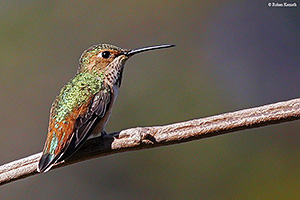 |
Allen's Hummingbird Selasphorus sasin |
|
| STANFORD LOCATIONS:
Uncommon spring migrant, seldom seen in summer or fall. Breeds in the adjacent foothills and possibly on campus, although nesting has not been recorded here. Most often observed foraging at feeders or flowering trees, especially eucalyptus. |
 |
Location |
Type |
Mating System |
Parental Care |
2ndary Diet |
Strategy |
|
|
|
|
I: 17-22 DAYS ALTRICIAL |
|
|
|
1'-20'(to 90') |
PROMISC? |
F |
|
|
| BREEDING: | Chaparral, thickets, brushy slopes, open coniferous forest. 2 broods. |
| DISPLAYS: | Male flies before female in J-shaped pattern, swooping down from a height of 75', making a prolonged metallic buzz at the bottom, then curving upward ca. 25' and hovering. Oft preceded and followed by pendulum like rocking display covering ca. 25'. |
| NEST: | Often on limb of conif or decid tree; of moss, forb stems, plant down, covered with lichen, bound with spider's silk, lined with plant down. Lichens continue to be added to exterior during incubation. Built in 8-11 days. |
| EGGS: | White, unmarked. 0.5" (13 mm). |
| DIET: | Includes spiders. |
| CONSERVATION: | Winters in Baja and c Mexico. |
| NOTES: | Nests often clustered, appearing semicolonial. Pugnacious defender of nest area. Adult males depart breeding grounds half a month before females; young males are last to leave, departing one month after adult males. |
| ESSAYS: | Hummingbird Foraging Bouts; Optimally Foraging Hummers; Hummingbirds, Nectar, and Water; Coevolution; Hovering Flight; Migration; Promiscuity |
| REFERENCES: | Johnsgard, 1983; Phillips, 1975; Tyrell and Tyrell, 1984 |
| Help | Abbreviations | Species-Alphabetical | Species-Taxonomic | Essays-Alphabetical | |
| Except for Stanford Locations, the material in this species treatment is taken, with permission, from The Birder's Handbook (Paul Ehrlich, David Dobkin, & Darryl Wheye, Simon & Schuster, NY. 1988). | |||||